高考英语阅读-主旨大意.doc
- 格式:doc
- 大小:180.02 KB
- 文档页数:8
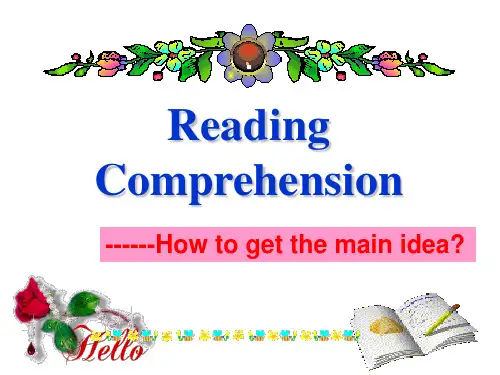
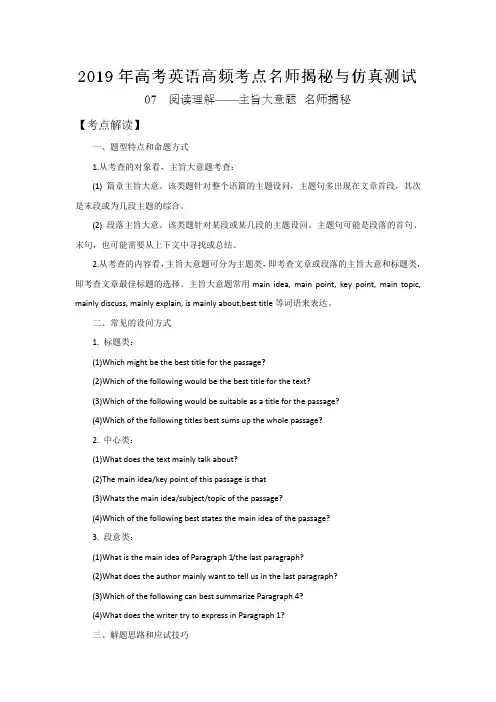
【考点解读】一、题型特点和命题方式1.从考查的对象看,主旨大意题考查:(1) 篇章主旨大意。
该类题针对整个语篇的主题设问,主题句多出现在文章首段,其次是末段或为几段主题的综合。
(2) 段落主旨大意。
该类题针对某段或某几段的主题设问。
主题句可能是段落的首句、末句,也可能需要从上下文中寻找或总结。
2.从考查的内容看,主旨大意题可分为主题类,即考查文章或段落的主旨大意和标题类,即考查文章最佳标题的选择。
主旨大意题常用main idea, main point, key point, main topic, mainly discuss, mainly explain, is mainly about,best title等词语来表达。
二、常见的设问方式1. 标题类:(1)Which might be the best title for the passage?(2)Which of the following would be the best title for the text?(3)Which of the following would be suitable as a title for the passage?(4)Which of the following titles best sums up the whole passage?2. 中心类:(1)What does the text mainly talk about?(2)The main idea/key point of this passage is that(3)Whats the main idea/subject/topic of the passage?(4)Which of the following best states the main idea of the passage?3. 段意类:(1)What is the main idea of Paragraph 1/the last paragraph?(2)What does the author mainly want to tell us in the last paragraph?(3)Which of the following can best summarize Paragraph 4?(4)What does the writer try to express in Paragraph 1?三、解题思路和应试技巧做主旨大意题应该从话题、主题段、主题句、语篇结构等方面入手,从全局的角度梳理文章脉络,并进行归纳概括。
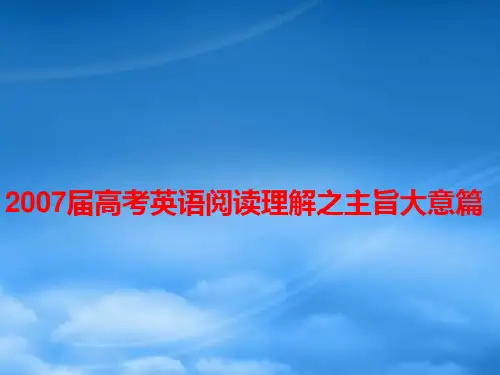

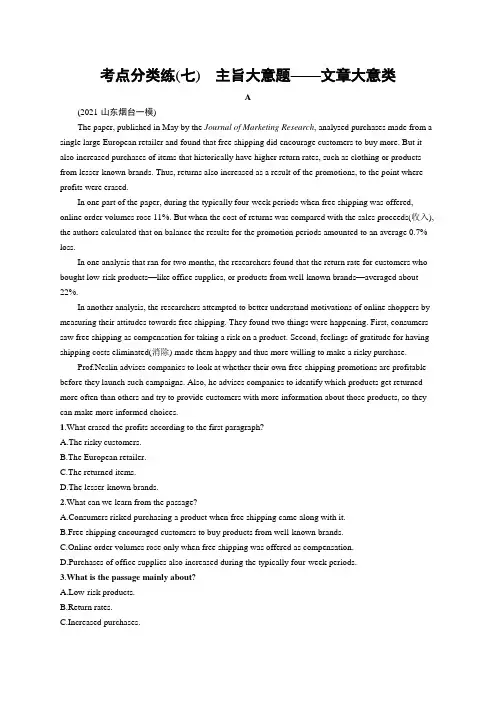
考点分类练(七)主旨大意题——文章大意类A(2021·山东烟台一模)The paper, published in May by the Journal of Marketing Research, analysed purchases made from a single large European retailer and found that free shipping did encourage customers to buy more. But it also increased purchases of items that historically have higher return rates, such as clothing or products from lesser-known brands. Thus, returns also increased as a result of the promotions, to the point where profits were erased.In one part of the paper, during the typically four-week periods when free shipping was offered, online order volumes rose 11%. But when the cost of returns was compared with the sales proceeds(收入), the authors calculated that on balance the results for the promotion periods amounted to an average 0.7% loss.In one analysis that ran for two months, the researchers found that the return rate for customers who bought low-risk products—like office supplies, or products from well-known brands—averaged about 22%.In another analysis, the researchers attempted to better understand motivations of online shoppers by measuring their attitudes towards free shipping. They found two things were happening. First, consumers saw free shipping as compensation for taking a risk on a product. Second, feelings of gratitude for having shipping costs eliminated(消除) made them happy and thus more willing to make a risky purchase.Prof.Neslin advises companies to look at whether their own free-shipping promotions are profitable before they launch such campaigns. Also, he advises companies to identify which products get returned more often than others and try to provide customers with more information about those products, so they can make more informed choices.1.What erased the profits according to the first paragraph?A.The risky customers.B.The European retailer.C.The returned items.D.The lesser-known brands.2.What can we learn from the passage?A.Consumers risked purchasing a product when free shipping came along with it.B.Free shipping encouraged customers to buy products from well-known brands.C.Online order volumes rose only when free shipping was offered as compensation.D.Purchases of office supplies also increased during the typically four-week periods.3.What is the passage mainly about?A.Low-risk products.B.Return rates.C.Increased purchases.D.Free shipping.B(2021·湖北黄冈高三4月模拟)An advance in electronic publishing could make the e-book you are reading seem as dated as a silent film. Publishers hope to explore the growing success of e-books by releasing versions with added soundtracks(电影原声音乐) and musical accompaniments.The noise in the first multimedia books—released in Britain—include the rain hitting a window in a Sherlock Holmes tale. When the plot of a book reaches the most exciting part, background scores will create tension.Supporters argue that sound effects are the next logical development for e-books and will add excitement for younger readers. Critics, however, will argue that the noise will ruin the simple pleasure of having the imagination stimulated by reading.Caroline Michel, chief executive of the literary agency, said the new generation of computer-literate readers was used to multiple sensory input. She said,“Young people have split computer screens where they may be watching television and replying to an email at the same time. If that’s what the market wants then we should respond to the market.”Booktrack’s sound effects work by estimating the user’s reading speed. Each time you “turn” a page, the software reassesses where you have reached in the text and times the sounds to switch on accordingly. If the soundtrack becomes out of sync(同步), a click on any word will reset it.Some authors fear that a soundtrack could destroy the peace and quiet of libraries and ruin the pleasure of reading. David Nicholls, author of Our Day, the best-seller now released as a film, said, “This sounds like the opposite of reading. I have enough trouble reading an e-book because I’m constantly distracted by emails.”Stuart MacBride sells 18% of his books as electronic downloads. He said,“If I’m reading, I will do the noise in my head. I don’t need someone to tell me what teacups clinking sounds like. That would irritate me.”4.What do publishers expect an e-book soundtrack to do?A.Help to release an e-book as a film.B.Help readers improve reading speed.C.Add tension at a book’s exciting point.D.Get readers familiar with the background.5.Who is in favour of added soundtracks for e-books?A.Sherlock Holmes.B.Caroline Michel.C.David Nicholls.D.Stuart MacBride.6.What do we know about Stuart MacBride?A.He was a person who was easy to get angry.B.He knew a great deal of tea.C.Eighty-two percent of his books described crime.D.He imagined sounds related to the story when reading.7.What’s the main idea of the passage?A.Opinions about e-books with soundtracks.B.Response to the need of the book market.C.Reasons for traditional e-books becoming outdated.D.Suggestions on encouraging readers’ imagination.C(2021·湖南长郡十五校高三联考)For most people, graduation is an exciting day of the celebration of years of hard work. My graduation day was not.I remember that weekend two years ago. Family and friends had flown in from across the country to attend the celebration. But just like everyone else in my class, I had watched the economy turn from bad to worse. What I thought would take a week dragged into two, and then four, and 100 job applications later, I found myself in the exact same spot as I was before. And the due date to begin paying back my student loan was drawing closer.You know that feeling when you wake up in fear? That feeling became a constant in my life. Days felt like weeks, weeks like months. And the most frustrating part was no matter how much I tried, I just couldn’t seem to make any progress.So what did I do to maintain my sanity(理智)? I decided to write. Something about putting words on a page made everything seem a little clearer—a little brighter. Something about writing gave me hope. And if you want something badly enough, sometimes a little hope is all you need! So I put my thoughts into a children’s book. And then one day, without any sort of writing degree or contacts in the writing world—just a lot of hard work and perseverance—I was offered a publishing contract for my first book! After that, things slowly began to fall into place. I was offered a second book deal. Then, a few months later, I got an interview and was hired shortly.The moral of this story is... don’t give up. Even if things look bleak now, don’t give up. If you work hard, things will always get better. Oftentimes all we need is the courage to overcome difficulties.8.From paragraph 2, we can learn that the author probably .A.was having an exciting graduationB.was getting into financial difficultiesC.missed the life in the universityD.had just applied for the student loan9.How did the author change the frustrating situation?A.By sending applications.B.By offering contracts.C.By keeping writing.D.By publishing books.10.Which of the following can replace the underlined word “bleak” in the last paragraph?A.Unattractive.B.Hopeless.C.Thrilling.D.Promising.11.What is the passage mainly about?A.Success belongs to the persevering.B.A contented mind is a permanent feast.C.A smooth sea never makes a skillful mariner.D.Misfortunes tell us what fortune is.考点分类练(七)主旨大意题——文章大意类【语篇导读】本文是一篇说明文。
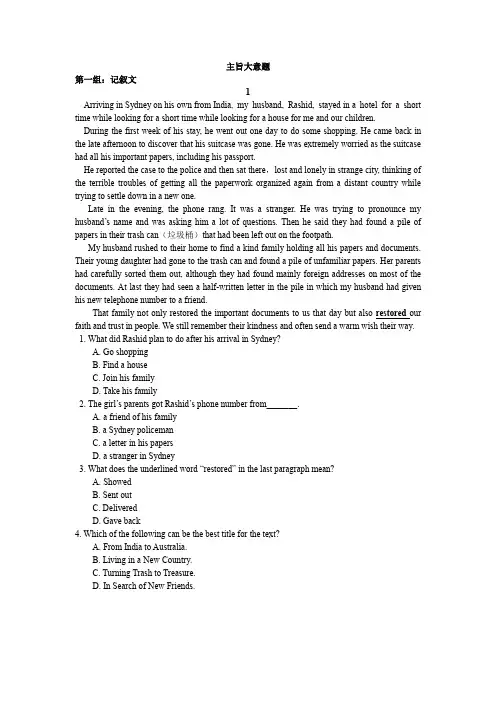
主旨大意题第一组:记叙文1Arriving in Sydney on his own from India, my husband, Rashid, stayed in a hotel for a short time while looking for a short time while looking for a house for me and our children.During the first week of his stay, he went out one day to do some shopping. He came back in the late afternoon to discover that his suitcase was gone. He was extremely worried as the suitcase had all his important papers, including his passport.He reported the case to the police and then sat there,lost and lonely in strange city, thinking of the terrible troubles of getting all the paperwork organized again from a distant country while trying to settle down in a new one.Late in the evening, the phone rang. It was a stranger. He was trying to pronounce my husband’s name and was asking him a lot of questions. Then he said they had found a pile of papers in their trash can(垃圾桶)that had been left out on the footpath.My husband rushed to their home to find a kind family holding all his papers and documents. Their young daughter had gone to the trash can and found a pile of unfamiliar papers. Her parents had carefully sorted them out, although they had found mainly foreign addresses on most of the documents. At last they had seen a half-written letter in the pile in which my husband had given his new telephone number to a friend.That family not only restored the important documents to us that day but also restored our faith and trust in people. We still remember their kindness and often send a warm wish their way.1. What did Rashid plan to do after his arrival in Sydney?A. Go shoppingB. Find a houseC. Join his familyD. Take his family2. The girl’s parents got Rashid’s phone number from_______.A. a friend of his familyB. a Sydney policemanC. a letter in his papersD. a stranger in Sydney3. What does the underlined word “restored” in the last paragraph mean?A. ShowedB. Sent outC. DeliveredD. Gave back4. Which of the following can be the best title for the text?A. From India to Australia.B. Living in a New Country.C. Turning Trash to Treasure.D. In Search of New Friends.A schoolgirl saved her father's life by kicking him in the chest after he suffered a serious allergic (过敏的) reaction which stopped his heart.Izzy, nine, restarted father Colm's heart by stamping (踩) on his chest after he fell down at home and stopped breathing.Izzy's mother, Debbie, immediately called 999 but Izzy knew doctors would never arrive in time to save her father, so decided to use CPR.However, she quickly discovered her arms weren't strong enough, so she stamped on her father's chestDebbie then took over with some more conventional chest compressions (按压) until the ambulanceIzzy, who has been given a bravery award by her school, said: "I just kicked him really hard. My mum taught me CPR but I knew I wasn't strong enough to use hands. I was quite scared. The doctor said I might as well be a doctor or a nurse. My mum said that Dad was going to hospital with a big footprint on his"She's a little star," said Debbie, "i was really upset but Izzy just took over. I just can't believe what she did. I really think all children should be taught first aid. Izzy did CPR then the doctor turned up. Colm had to have more treatment on the way to the hospital and we've got to see an expert."Truck driver Colm, 35, suffered a mystery allergic reaction on Saturday and was taken to hospital, but was sent home only for it to happen again the next day. The second attack was so serious that his airway swelled, preventing him from breathing, his blood pressure dropped suddenly, and his heart stopped for a moment.He has now made a full recovery from his suffering.39. Izzy kicked her father in the chest ______ .A. to express her helplessnessB. to practise CPR on himC. to keep him awakeD. to restart his heart40. What's the right order of the events?○1Izzy kicked Colm.○2Debbie called 999.○3Izzy learned CPR.○4Colm's heart stopped.A. 3 1 2 4B. 4 2 3 1C. 3 4 2 1D. 4 3 1 241. What does Paragraph 8 mainly talk about?A. What Colm suffered.B. Colm's present condition.C. What caused Colm's allergy.D. Symptoms of Colm's allergic reaction.42. Why does the author write the news?A. To describe a serious accident.B. To prove the importance of CPR.C. To report a 9-year-old girl's brave act.D. To call people's attention to allergic reaction.I was never very neat, while my roommate Kate was extremely organized. Each of her objects had its place, but mine always hid somewhere. She even labeled (贴标签) everything. I always looked for everything. Over time, Kate got nearer and I got messier. She would push my dirty clothing over, and I would lay my books on her tidy desk. We both got tired of each other.War broke out one evening. Kate came into the room. Soon, I heard her screaming, "Take your shoes away! Why under my bed!" Deafened, I saw my shoes flying at me. I jumped to my feet and started yelling. She yelled back louder.The room was filled with anger. We could not have stayed together for a single minute but for a phone call. Kate answered it. From her end of the conversation, I could tell right away her grandma was seriously ill. When she hung up, she quickly crawled (爬) under her covers, sobbing.Obviously, that was something she should not go through phone. All of a sudden, a warm feeling of sympathy rose up in my heart,Slowly, I collected the pencils, took back the books, made my bed, cleaned the socks and swept the floor, even on her side. I got so into my work that I even didn't noticed Kate had sat up.She was watching, her tears dried and her expression one of disbelief. Then, she reached out her hands to grasp mine. I looked up into her eyes. She smiled at me. "Thanks."Kate and I stayed roommates for the rest of the year. We didn't always agree, but we learned the key to living together: giving in. cleaning up and holding on.36. What made Kate angry one evening?A. She couldn't find her books.B. She heard the author shouting loud.C. She got the news that her grandma was ill.D. She saw the author's shoes beneath her bed.37. The author tidied up the room most probably because___.A. she was scared by Kate's angerB. she hated herself for being so messyC. she wanted to show her careD. she was asked by Kate to do so38. How is Paragraph I mainly developed?A. By analyzing causes.B. By showing differences.C. By describing a process.D. By following time order.39. What might be the best title for the story?A. My Friend KateB. Hard Work Pays OffC. How to Be OrganizedD. Learning to Be RoommatesElizabeth Freeman was born about 1742 to African American parents who were slaves. At the age of six months she was acquired, along with her sister, by John Ashley, a wealthy Massachuset ts slaveholders. She became known as “Mumbet” or “Mum Bett.”For nearly 30 years Mumbet served the Ashley family. One day, Ashley’s wife tried to strike Mumbet’s sister with a spade. Mumbet protected her sister and took the blow instead. Furious, she left the house and refused to come back. When the Ashleys tried to make her return, Mumbet consulted a lawyer, Theodore Sedgewick. With his help, Mumbet sued(起诉) for her freedom.While serving the Ashleys, Mumbet had listened to many discussions of the new Massachusetts constitution. If the constitution said that all people were free and equal, then she thought it should apply to her. Eventually, Mumbet won her freedom---- the first slave in Massachusetts to do so under the new consititution.Strangely enough, after the trial, the Ashleys asked Mumbet to come back and work for them as a paid employee. She declined and instead went to work for Segdewick. Mumbet died in 1829, but her legacy lived on in her many descendants(后裔). One of her great-grandchildren was W.E.B. Du Bois, one of the founder of the NAACP, and an important writer and spokesperson for African American civil rights.Mumbet’s tombstone still stands in the Massachusetts cemetery where she was buried. It reads, in part: “She was born a slave and rema ined a slave and remained a slave for nearly thirty years. She could neither read nor write, yet in her own sphere she had no superior or equal.”51. What do we know about Mumbet according to Paragraph 1?A. She was born a slaveB. She was a slaveholderC. She had a famous sisterD. She was born into a rich family52. Why did Mumbet run away from the Ashleys?A. She found an employerB. She wanted to be a lawyerC. She was hit and got angryD. She had to take care of her sister53. What did Mumbet learn from discussions about the new consititution?A. She should always obey her owners’ ordersB. She should be as free and equal as whitesC. How to be a good servantD. How to apply for a job54. What did Mumbet do after the trial?A. She chose to work for a lawyerB. She found the NAACPC. She continued to serve the AshleysD. She went to live with her grandchildren55. What is the test mainly about?A. A story of a famous writer and spokespersonB. The friendship between a lawyer and a slaveC. The life of a brave African American womanD. A trial that shocked the whole world5It was Mother’s Day morning last year and I was doing my shopping at our local supermarket with my five-year-old son, Tenyson. As we were leaving, we found that only minutes earlier an elderly woman had fallen over at the entrance and had hit her head on the concrete. Her husband was with her, but there was blood everywhere and the woman was embarrassed and clearly in shock.Walking towards the scene, Tenyson became very upset about what had happened to the couple. He said to me, “Mum, it’s not much fun falling over in front of everyone.”At the front of the supermarket a charity(慈善) group had set up a stand selling cooked sausages and flowers to raise funds. Tenyson suggested that we should buy the lady a flower. “It will make her feel better,” he said. I was amazed that he’d come up with such a sweet idea. So we went over to the flower seller and asked her if we could buy a flower for the lady to cheer her up. “Just take it,” she replied. “I can’t take your money for such a wonderful gesture.”By now paramedics(救援人员)had arrived, and were attending the injured woman. As we walked up to her, my son became intimidated by all the blood and medical equipment. He said he was just too scared to go up to her. ZXXKInstead I gave the flower to the woman’s husband and told him, “My son was very upset for your wife and wanted to give her this flower to make her feel better.”At that, the old man started crying and said, “Thank you so much, you have a wonderful son. Happy Mother’s Day to you.”The man then bent down and gave his wife the flower, telling her who it was from. Though badly hurt and shaken, the old lady looked up at Tenyson with love in her eyes and gave him a little smile.56. What does the author intend to tell us?A. One can never be too careful.B. Actions speak louder than words.C. Love begins with a little smile.D. A small act of kindness brings a great joy.57. Which of the following is TRUE according to the passage?A. The elderly woman was knocked down by Tenyson.B. Tenyson’s idea of buying a flower gained his father’s support.C. Tenyson’s care for the elderly woman puzzled the flower seller.D. The elderly woman was moved to tears by Tenyson’s gesture.58. The underlined word “intimidated” in the fourth paragraph probably means “___________”.A. astonishedB. struckC. frightenedD. excited59. What would be the best title for the passage?A. Flower PowerB. Mother’s DayC. An Accidental InjuryD. An Embarrassing Moment6In the mid-1950s, I was a somewhat bored early-adolescent male student who believed that doing any more than necessary was wasted effort. One day, this approach threw me into embarrassment.In Mrs. Totten’s eighth-grade math class at Central Avenue School in Anderson, Indiana, we were learning to add and subtract decimals (小数).Our teacher typically assigned daily homework, which would be recited in class the following day. On most days, our grades were based on our oral answer to homework questions.Mrs. Totten usually walked up and down the rows of desks requesting answers from student after student in the order the questions had appeared on our homework sheets. She would start either at the front or the back of the classroom and work toward the other end.Since I was seated near the middle of about 35 students, it was easy to figure out whichquestions I might have to answer. This particular time, I had completed my usual two or three problems according to my calculations.What I failed to expect was that several students were absent, which threw off my estimate. As Mrs. Totten made her way from the beginning of the class,I desperately tried to determine which math problem I would get. I tried to work it out before she got to me, but I had brain freeze and couldn’t function.When Mrs. Totten reached my desk,she asked what answer I’d got for problem No. 14. “I (I)didn’t get anything,” I answered,and my face felt warm.“Correct,” she said.It turned out that the correct answer was zero.What did I lea rn that day? First, always do all your homework. Second, in real life it isn’t always what you say but how you say it that matters. Third,I would never make it as a mathematician.If I could choose one school day that taught me the most, it would be that one.61. What does the underlined part in Paragraph 1 indicate?A. It is wise to value one’s time.B. It is important to make an effortC. It is right to stick to one’s belief.D. It is enough to do the necessary.62. Usually, Mrs. Totten asked her students to _______.A. recite their homework togetherB. grade their homework themselvesC. answer their homework questions orallyD. check the answers to their homework questions63. The author could work out which questions to answer since the teacher always _______.A. asked questions in a regular wayB. walked up and down when asking questionsC. chose two or three questions for the studentsD. requested her students to finish their usual questions64. The author failed to get the questions he had expected because _______.A. the class didn’t begin as usualB. several students didn’t come to schoolC. he didn’t try hard to make his estimateD. Mrs. Totten didn’t start from the back of the class65,Which of the following can be the best title for the passage?A. An Unforgettable TeacherB. A Future MathematicianC. An Effective ApproachD. A Valuable Lesson7Samuel Osmond is a 19-year-old law student from Cornwall, England. He never studied the piano. However, he can play very difficult musical pieces by musicians such as Chopin and Beethoven just a few minutes after he hears them. He learns a piece of music by listening to it in parts. Then he thinks about the notes in his head. Two years ago, he played his first piece Moonlight Sonata(奏鸣曲)by Beethoven. He surprised everyone around him.Amazed that he remembered this long and difficult piece of music and played it perfectly, his teachers say Samuel is unbelievable .They say his ability is ver y rare, but Samuel doesn’t even realize that what he can do is special. Samuel wanted to become a lawyer as it was the wish of his parents, but music teachers told him he should study music instead. Now, he studies law and music.Samuel can’t understand why everyone is so surprised. “I grew up with music. My mother played the piano and my father played the guitar. About two years ago, I suddenly decided to start playing the piano, without being able to read music and without having any lessons. It comes easily to me ---I hear the notes and can bear them in mind---each and every note,” says Samuel.Recently, Samuel performed a piece during a special event at his college. The piece had more than a thousand notes. The audience was impressed by his amazing performance. He is now learning a piece that is so difficult that many professional pianists can’t play it. Samuel says confidently,” It’s all about super memory---I guess I have that gift.”However, Samuel’s ability to remember things doesn’t stop with music. His family says that even when he was a young boy, Samuel heard someone read a story, and then he could retell the story word for word.Samuel is still only a teenager. He doesn’t know what he wants to do in the future. For now, he is just happy to play beautiful music and continue his studies.26.What is special about Samuel Osmond?A. He has a gift for writing music.B. He can write down the note he hears.C. He is a top student at the law school.D. He can play the musical piece he hears.27.What can we learn from Paragraph 2?A. Samuel chose law against the wish of his parents.B.B. Samuel planned to be a lawyer rather than a musician.C. Samuel thinks of himself as a man of great musical ability.D. Samuel studies law and music on the advice of his teachers.28.Everyone around Samuel was surprised because he _________.A.received a good early education in musicB. played the guitar and the piano perfectlyC.could play the piano without reading musicD. could play the guitar better than his father29.What can we infer about Samuel in Paragraph 4?A.He became famous during a special event at his college.B.He is proud of his ability to remember things accurately.C.He plays the piano better than many professional pianists.D.He impressed the audience by playing all the musical pieces.30.Which of the following is the best title of the passage?A.The Qualities of a MusicianB. The Story of a Musical TalentC. The Importance of Early EducationD. The Relationship between Memory and Music.8Poet William Stafford once said that we are defined more by the detours(绕行路)in life that by the narrow road toward goals. I like this image. But I as quite by accident that I discovered the deep meaning of his words.For years we made the long drive from our home in Seattle to my parents’ home in Boise in nine hours. We traveled the way most people do: the fastest, shortest easiest road, especially when I was alone with four noisy, restless kids who hates confinement(限制)and have strong opinions about everything.Road trips felt risky, so I would drive fast, stopping only when I had to. We would stick to the freeways and arrive tired.But then Banner, our lamb was born. He was rejected by his mama days before our planned trip to Boise. I had two choices: leave Banner with my husband, or take him with me. My husband made the decision for me.That is how I found myself on the road with four kids, a baby lamb and nothing but my everlasting optimism to see me through. We took the country roads out of necessity. We had to stop every hour, let Banner shake out his legs and feed him. The kids chased him and one another. They’d get back in the car breathless and energized, smelling fresh from the cold air.We explored side roads, catching grasshoppers in waist-high grass. Even if we simply looked out of the car windows at baby pigs following their mother, or fish leaping out of the water, it was better than the best ride down the freeway. Here was life. And new horizons(见识).We eventually arrived at my parents’ doorstep astonishingly fresh and full of storiesI grew brave with the trip back home and creative with my disciplining technique. On an empty section of road, everyone started quarreling. I stopped the car, ordered all kids out and told them to meet me up ahead. I parked my car half a mile away and read my book in sweet silence.Some road trips are by necessity fast and straight. But that trip with Banner opened our eyes to a world available to anyone adventurous enough to wander around and made me realize that a detour may uncover the best part of a journey----and the best part of yourself.46. Why did the author use to take freeways to her parents’ home?A. It was less timeB. It would be faster and saferC. Her kids would feel less confinedD. She felt better with other drivers nearby47. The author stopped regularly on the country roads toA. relax in the fresh airB. take a deep breathC. take care of the lambD. let the kids play with Banner48. What does the author discover from the trip according to Paragraph 6?A. Freeways are where beauty hides.B. Getting close to nature adds to the joy of lifeC. Enjoying the beauty of nature benefits one’s healthD. One should follow side roads to watch wild animals49. Why did the author ask the kids to get out of the car on their way back home?A. To give herself some time to readB. To order some food for themC. To play a game with them.D. To let them cool down50. What could be the best title for the passage?A. Charm of the DetourB. The Road to BraveryC. Creativity out of NecessityD. Road trip and Country Life第二组:说明文,应用文1Would it surprise you to learn that, like animals, trees communicate with each other and pass on their wealth to the next generation?UBC Professor Simard explains how trees are much more complex than most of us ever imagined. Although Charles Darwin thought that trees are competing for survival of the fittest, Simard shows just how wrong he was. In fact, the opposite is true: trees survive through their co-operation and support, passing around necessary nutrition “depending on who needs it”.Nitrogen (氮) and carbon are shared through miles of underground fungi(真菌) networks, making sure that all trees in the forest ecological system give and receive just the right amount to keep them all healthy. This hidden system works in a very similar way to the networks of neurons(神经元) in our brains, and when one tree is destroyed, it affects all.Simard talks about “mother trees”, usually the largest and oldest plants on which all other trees depend. She explains how dying trees pass on the wealth to the next generation, transporting important minerals to young trees so they may continue to grow. When humans cut down “mother trees” with no awareness of these highly complex “tree societies” or the networks on which they feed, we are reducing the chances of survival for the entire forest.“We didn’t take any notice of it,” Simard says sadly, “Dying trees move nutrition into the young trees before dying, but we never give them chance.” If we could put across the message to the forestry industry, we could make a huge difference towards our environmental protection efforts for the future.29. The underlined sentence “the opposite is true” in Paragraph 2 probably means thattrees__________.A. compete for survivalB. protect their own wealthC. depend on each otherD. provide support for dying trees30. “Mother tress” are extremely important because they________.A. look the largest in size in the forestB. pass on nutrition to young treesC. seem more likely to be cut down by humansD. know more about the complex “tree societies”31. The underlined word “it” in the last paragraph refers to _______A. how “tree societies” workB. how trees grow oldC. how forestry industry developsD. how young trees survive32. What would be the best title for the passage?A. Old Trees Communicate Like HumansB. Young Trees Are In Need of ProtectionC. Trees Are More Awesome Than You ThinkD. Trees Contribute To Our Society2How fit are your teeth? Are you lazy about brushing them? Never fear: An inventor is on the case. An electric toothbrush senses how long and how well you brush, and it lets you track your performance on your phone.The Kolibree toothbrush was exhibited at the International Consumer Electronics Show in Las Vegas this week. It senses how it is moved and can send the information to an Android phone or iPhone via a Bluetooth wireless connection.The toothbrush will be able to teach you to brush right (don’t forget the insides of the teeth!) and make sure you’re brushing long enough. “It’s kind of like havin g a dentist actually watch your brushing on a day-to-day basis,” says Thomas Serval, the French inventor.The toothbrush will also be able to talk to other applications on your phone, so developers could, for instance, create a game controlled by your toothbrush. You could score points for beating monsters among your teeth. “We try to make it smart but also fun,” Several says.Serval says he was inspired by his experience as a father. He would come home from work and ask his kids if they had brushed their t eeth. They said “yes,” but Serval would find their toothbrush heads dry. He decided he needed a brush that really told him how well his children brushed.The company says the Kolibree will go on sale this summer, for $99 to $199, developing on features. The U.S. is the first target market.Serval says that one day, it’ll be possible to replace the brush on the handle with a brushing unit that also has a camera. The camera can even examine holes in your teeth while you brush.56. Which is one of the feature of the Kolibree toothbrush?A. It can sense how users brush their teeth.B. It can track users’ school performance.C. It can detect users’ fear of seeing a dentist.D. It can help users find their phones.57. What can we learn from Serval’s words in Par agraph 3?A. You will find it enjoyable to see a dentist.B. You should see your dentist on a day-to –day basis.C. You can brush with the Kolibree as if guided by a dentist.D. You’d like a dentist to watch you brush your teeth every day.58. Which of the following might make the Kolibree toothbrush fun?A. It can be used to update mobile phones.B. It can be used to play mobile phone gamesC. It can send messages to other usersD. It can talk to its developers.59. What is Paragraph 5 mainly about?A. How Serval found out his kids lied to him.B. Why Serval thought brushing teeth was necessary.C. How Serval taught his kids to brush their teeth.D. What inspired Serval to invent the toothbrush?60. What can we infer about Serval’s children?A. They were unwilling to brush their teethB. They often failed to clean their toothbrushes.C. They preferred to use a toothbrush with a dry head.D. They liked brushing their teeth after Serval came home.61. What can we learn about the future development of the Kolibree?A. The brush handle will be removed.B. A mobile phone will be built into it.C. It will be used to fill holes in teethD. It will be able to check users’ teeth3People aren’t walking any more---if they can figure out a way to avoid it.I felt superior about this matter until the other day I took my car to mail a small parcel. The journey is a matter of 281 steps. But I used the car. And I wasn’t in a hurry, either, I had merely become one more victim of a national sickness: motorosis.It is an illness to which I had thought myself immune, for I was bred in the tradition of going to places on my own two legs. At that time, we regarded 25 miles as good day’s walk and the ability to cover such a distance in ten hours as sign of strength and skill. It did not occur to us that walking was a hardship. And the effect was lasting. When I was 45 years old I raced –and beat—a teenage football player the 168 steps up the Stature of Liberty.Such enterprises today are regarded by many middle-aged persons as bad for the heart. But a well-known British physician, Sir Adolphe Abrhams, pointed out recently that hearts and bodies need proper…… is more likely to have illnesses than one who exercises regularly. And walking is an ideal form of exercise--- the most familiar and natural of all.It was Henry Thoreau who showed mankind the richness of going on foot. The man walking can learn the trees, flower, insects, birds and animals, the significance of seasons, the very feel of himself as a living creature in a living world, He cannot learn in a car.The car is a convenient means of transport, but we have made it our way of life. Many people don’t dare to approach Nature anymore; to them the world they were born to enjoy is all threat. To them security is a steel river thundering on a concrete road. And much of their thinking takes place while waiting for the traffic light to turn green.I say that the green of forests is the mind’s best light. And none but the man on foot can evaluate what is basic and everlasting.51. What is the national sickness?A. Walking too muchB. Traveling too muchC. Driving cars too muchD. Climbing stairs too much.52. What was life like when the author was young?A. People usually went around on foot.。
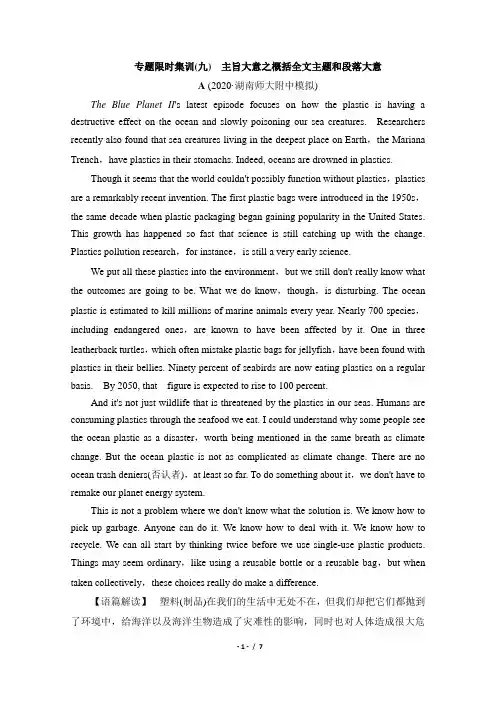
专题限时集训(九)主旨大意之概括全文主题和段落大意A (2020·湖南师大附中模拟)The Blue Planet II's latest episode focuses on how the plastic is having a destructive effect on the ocean and slowly poisoning our sea creatures. Researchers recently also found that sea creatures living in the deepest place on Earth,the Mariana Trench,have plastics in their stomachs. Indeed, oceans are drowned in plastics.Though it seems that the world couldn't possibly function without plastics,plastics are a remarkably recent invention. The first plastic bags were introduced in the 1950s,the same decade when plastic packaging began gaining popularity in the United States. This growth has happened so fast that science is still catching up with the change. Plastics pollution research,for instance,is still a very early science.We put all these plastics into the environment,but we still don't really know what the outcomes are going to be. What we do know,though,is disturbing. The ocean plastic is estimated to kill millions of marine animals every year. Nearly 700 species,including endangered ones,are known to have been affected by it. One in three leatherback turtles,which often mistake plastic bags for jellyfish,have been found with plastics in their bellies. Ninety percent of seabirds are now eating plastics on a regular basis. By 2050, that figure is expected to rise to 100 percent.And it's not just wildlife that is threatened by the plastics in our seas. Humans are consuming plastics through the seafood we eat. I could understand why some people see the ocean plastic as a disaster,worth being mentioned in the same breath as climate change. But the ocean plastic is not as complicated as climate change. There are no ocean trash deniers(否认者),at least so far. To do something about it,we don't have to remake our planet energy system.This is not a problem where we don't know what the solution is. We know how to pick up garbage. Anyone can do it. We know how to deal with it. We know how to recycle. We can all start by thinking twice before we use single-use plastic products. Things may seem ordinary,like using a reusable bottle or a reusable bag,but when taken collectively,these choices really do make a difference.【语篇解读】塑料(制品)在我们的生活中无处不在,但我们却把它们都抛到了环境中,给海洋以及海洋生物造成了灾难性的影响,同时也对人体造成很大危害。
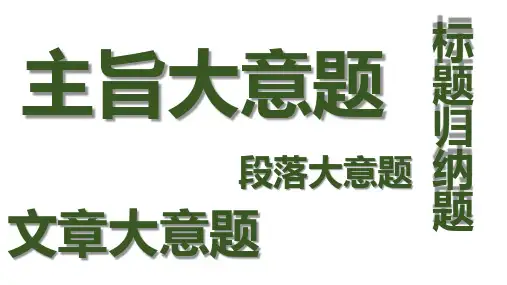
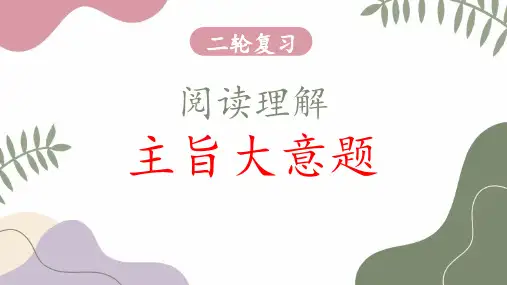
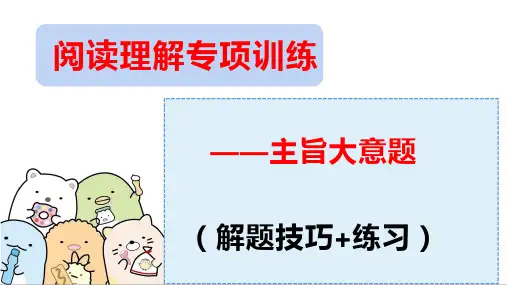
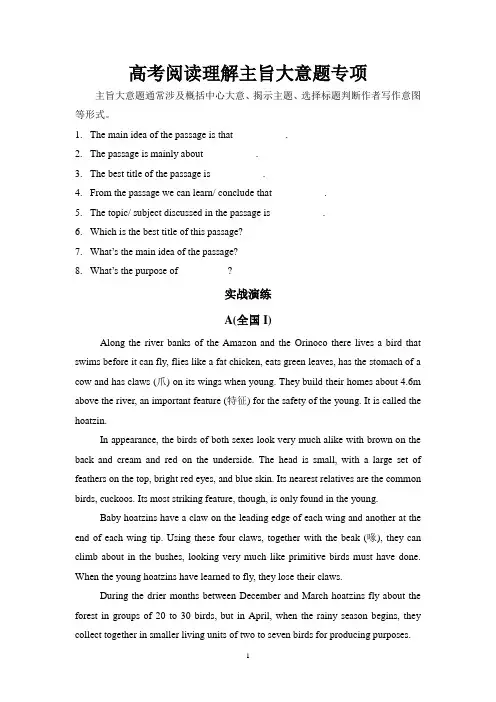
高考阅读理解主旨大意题专项主旨大意题通常涉及概括中心大意、揭示主题、选择标题判断作者写作意图等形式。
1.The main idea of the passage is that __________.2.The passage is mainly about __________.3.The best title of the passage is __________.4.From the passage we can learn/ conclude that __________.5.The topic/ subject discussed in the passage is __________.6.Which is the best title of this passage?7.What’s the main idea of the passage?8.What’s the purpose of__________?实战演练A(全国I)Along the river banks of the Amazon and the Orinoco there lives a bird that swims before it can fly, flies like a fat chicken, eats green leaves, has the stomach of a cow and has claws (爪) on its wings when young. They build their homes about 4.6m above the river, an important feature (特征) for the safety of the young. It is called the hoatzin.In appearance, the birds of both sexes look very much alike with brown on the back and cream and red on the underside. The head is small, with a large set of feathers on the top, bright red eyes, and blue skin. Its nearest relatives are the common birds, cuckoos. Its most striking feature, though, is only found in the young.Baby hoatzins have a claw on the leading edge of each wing and another at the end of each wing tip. Using these four claws, together with the beak (喙), they can climb about in the bushes, looking very much like primitive birds must have done. When the young hoatzins have learned to fly, they lose their claws.During the drier months between December and March hoatzins fly about the forest in groups of 20 to 30 birds, but in April, when the rainy season begins, they collect together in smaller living units of two to seven birds for producing purposes.1. What is the text mainly about?A. Hoatzins in dry and rainy seasons.B. The relatives and enemies of hoatzins.C. Primitive birds and hoatzins of the Amazon.D. The appearance and living habits of hoatzins.2. Young hoatzins are different from their parents in that_________ .A. they look like young cuckoosB. they have claws on the wingsC. they eat a lot like a cowD. they live on river banks3. What can we infer about primitive birds from the text?A. They had claws to help them climb.B. They could fly long distances.C. They had four wings like hoatzins.D. They had a head with long feathers on the top.4. Why do hoatzins collect together in smaller groups when the rainy season comes?A. To find more food.B. To protect themselves better.C. To keep themselves warm.D. To produce their young.B(全国卷I )Science can't explain the power of pets, but many studies have shown that the company of pets can help lower blood pressure (血压) and raise chances of recovering from a heart attack, reduce loneliness and spread all-round good cheer.Any owner will tall you how much joy a pet brings. For some, an animal provides more comfort than a husband/wife. A 2002 study by Karen Allen of the State University of New York measured stress (紧张) levels and blood pressure in people - half of them pet owners –while they performed 5 minutes of mental arithmetic (算术) or held a hand in ice water. Subjects completed the tasks alone, with a husband/wife, a close friend or with a pet. People with pets did it best .Those testedwith their animal friends had smaller change in blood pressure and returned. Most quickly to baseline heart rates .With pets in the room, people also made fewer math mistakes. Than when doing in front of other companions. It seems people feel more released (放松)around Pets, says Allen, who thinks it may be because pets don’t judge.A study reported last fall suggests that having a pet dog not only raises your spirits but may also have an effect on your eating habits. Researchers at Northwestern Memorial Hospital spent a Year studying 36 fat people and were put on a diet-and-exercise programs; a separate group of 56 fat people without pets were put on a diet program. On average,people lost about 11 pounds,Or 5% of their body weight .Their dogs did even better,losing an average of 12 pounds,more then 15%of their body weight .Dog owners didn’t lose any more weight than those without dogs but ,say Researchers,got more exercise overall –mostly with their dogs –and found it worth doing.1.What does the text mainly discuss?A. What pets bring to their ownersB. How pets help people calm downC. people’s opinions of keeping petsD. Pet’s value in medical research2.We learn from the text that a person with heart disease has a better chance of getting well if____________A. he has a pet companionB. he has less stress of workC. he often dose mental arithmeticD. he is taken care of by his family3.According to Allen, why did the people do better with pets around when facing stressful tasks?A. They have lower blood pressure.B. They become more patient.C. They are less nervous.D. They are in higher spirits.4.The research mentioned in the last paragraph reports that __________.A. people with dogs did more exerciseB. dogs lost the same weight as people didC. dogs liked exercise much more than people didD. people without dogs found the program unhelpfulC(天津)To err is human. To blame the other guy is even more human.Common sense is not all that common.Why tell the truth when you can come up with a good excuse?These three popular misquotes(戏谑的引语)are meant to be jokes, and yet they tell us a lot about human nature .To err, or to make mistakes, is indeed a part of being human, but it seems that most people don’t want to accept the responsibili ty for the problem. Perhaps it is the natural thing to do .The original quote about human nature went like this:” To err is human, to forgive, divine(神圣的).”This saying mirrors an i deal people should be forgiving of others’ mistakes. Instead, we tend to do the opposite –find someone else to pass the blame on to. However, taking responsibility for something that went wrong is a mark of great maturity.Common sense is what we call clear thought. Having common sense means having a good general plan that will make things work well, and it also means staying with the plan. Commonsense tells you that you take an umbrella out into a rainstorm, but you leave the umbrella home when you hear a weather forecast for sunshine.Common sense does not seem to be common for large organizations, because there are so many things going on that one person cannot be in charge of everything. People say that in a large company,” the right hand does not know what the left hand is doing.”And what is wrong with a society that thinks that making up a good excuse is like creating a work of art? One of the common problems with making excuses is that people, especially young people. Get the idea that it’s okay not to be totally honest all the time. There is a corollary(直接推论)to that: if good excuse is “good” even if it isn’t honest, then where is the place of the truth?1. According to the passage, which of following seems the most human?A. To search for truth.B. To achieve one’s idealC. To make fun of others’ mistakes.D. To criticize others for one’s own error. 2.According to the author, what is a sign of a man’s mat urity?A. Doing things his own way.B. Bearing responsibility for his mistakes.C. Making as few mistakes as possible.D. Thinking seriously about his wrongdoing.3.Which of the following is NOT based on common sense?A. A man tries to take charge of everything in a large company.B. A student goes out with an umbrella in stormy weather.C. A company’s next move follows a good plan.D. A lawyer acts on fine judgments.4. What is the author’s opinion about a good excuse?A. Making a good excuse is sometimes a better policy.B. Inventing a good excuse needs creative ideas.C. A good excuse is as rewarding as honesty.D. Bitter truth is better than a good excuse.5. What would be the best title for his passage?A. A Mirror of Human NatureB. To Blame or to ForgiveC. A Mark of MaturityD. Truth or ExcuseD(重庆)Sitting on the peaceful coast of the Galapagos Islands. Ecuador , watching the sun move quietly into the sea, you shouldn’t forget the Charles Darwin (1809 – 1882) arrived here in 1835. He stayed on the islands for five weeks, observing various animals. This finally inspired(启发) his famous work, On the Origin of Species. You can certainly follow Darwin’s footsteps and enjoy a trip from four to seven days to theislands.The islands are certainly a paradise (天堂) for wildlife, as there are no natural killers on the islands and the number of boats and visitors is under government control. Though you cannot walk freely as Darwin die hour 200 years ago ,each day is as impressive as it could be.The most well crown animal of the Galapagos is the giant tortoise ( 巨型陆龟),which can be seen moving slowly around the highlands of Santa Cruz, the second largest island in the archipelago(群岛). Some of these creatures are so old that they might have been seen in their youth by Darwin himself.Despite strict control over activities and timing, you stay on the Galapagos will be remembered as a chain of incomparable pictures; diving with sea how that swim and play within inches of you; feeling small sharks touch you feet as you swim and ,most magically , seeing a with and her baby surface with great breath of air.Traveling between the islands and observing the wildlife that so inspired Darwin, you will fell as though you are getting a special view of an untouched world .At night you will sleep on board the ship , leaving the wildlife in complete occupation of the islands, which are as undisturbed now as they have been since the beginning of time.1. What do we know about Darwin’s visit to the islands?A. He studied different creatures on the islands.B. He completed his famous book on the islands.C. He was touched by the geography of the islands.D. He was attracted by well-known animals of the islands.2. Which of the following plays a role in making the islands “a paradise for wildlife”?A. Animals on the islands feed on grass.B. Local government forbids killing wildlife.C. People cannot visit the islands as they wish.D. Tourists are not allowed to torch the animals.3.Your stay on the islands will be most impressive mainly because of .A. the beautiful sea viewsB. Darwin’s inspiring tripC.a closer view of animals D. various daring activities4.Which of the following would be the best title for the passage?A. A Unique Attraction for Wildlife LoversB. Galapagos as a Paradise for AdventurersC. Charles Darwin as a Symbol of GalapagosD. A Successful Example of Wildlife ProtectionE(重庆)Humans are naturally drawn to other life forms and the worlds outside of our own. We take delight in the existence of creatures and even whole societies beyond our everyday lives.This sense of wonder is universal look at the efforts that scientists have made to find out whether life of some kind exists on Mars, and the popularity of fantasy(幻想) literature or movies like The lord of the Rings, This sense of wonder draws us to each other, to the world around us, and to the world of make-believe. But have we gone to far in creating worlds of fantasy that we are missing the pleasure of other worlds that already exist all around us?Human beings, as biologists have suggested, possess an inborn desire to connect with and understand other life forms, however, people, especially in big cities, often lead rather isolated lives. In a study of British schoolchildren, it was found that children by age eight were much more familiar with characters for television shows and video games than with common wildlife. Without modern technology, a small pond could be an amazing world filled with strange and beautiful plants, insects, birds, and animals. When we lack meaningful interaction (交互) with the world around us, and sometimes even with our families and friends , we seek to understand and communicate with things that exist only in our imaginations or on a computer screen The world of make-believe is not necessarily bad, But when the world of fantasy becomes the only outlet (出路) our sense of wonder, then we are really missing something, We are missing a connection with the living world. Otherwonderful wonderful worlds exist all around us. But even more interesting is that if we look closely enough, we can see that these worlds, in a broad sense, are really part of our own.1. The popularity of The Lord of the Rings proves ___ .A. the close connection between man and the fantasy worldB. the wonderful achievements of fantasy literatureC. the fine taste of moviegoers around the worldD. the general existence of the sense of curiosity2. What can we infer from the underlined sentence in Paragraph 3?A. People are far less familiar with the world of fantasy.B. The world around us could serve as a sound of wonder.C. The world of fantasy can be mirrored by a small and lively pond.D. Modern technology prevents us from developing our sense of wonder.3. If our sense of wonder relies totally on the world of make-believe. We will______.A. fail to appreciate the joy in our livesB. be confused by the world of make-believeC. miss the chance to recognize the fantasy worldD. be trapped by other worlds existing all around us4. What is the main purpose of the passage?A. To show us the hidden beauty in our world.B. To warn us not to get lost in the fantasy wonderC. To argue against the misuse of the sense of wonderD. To discuss the influence of the world of make-believe。
阅读理解(主旨大意题)1.(2023·广东深圳·高三统考期末)Boston wants to be smarter. The city has taken advantage of technologies to become more responsive to its residents' needs. But technology alone is not sufficient to make today's cities liveable. Boston has discovered that it also needs to reach the old-fashioned low-tech community and integrate that technology with city life.Kris Carter rolled out Boston's smart city program in 2014. It started with an App that residents could download to report locations where sidewalks needed repair. The city sorted out those reports and ranked them in a database, which repair crews used to prioritize their work.The system worked beautifully, except for one problem: most of the alerts(警报) came from wealthier neighborhoods, where the concentration of smartphone - equipped residents was highest. "The complaints from the App didn't always correlate with the greatest community need for repairs, " explains Carter.Carter's group has moved away from the model common to many smart city initiatives of letting tech-savvy(精通技术的)residents drive the process. Instead, they run meetings to find out what problems people in different neighborhoods care about solving. When it came to sidewalks, Boston introduced a second method of collecting repair tips, hiring people to get out and walk the city's 1,700 miles of sidewalks to take notes on their condition.Whether using low-tech or high-tech approaches, says Carter, to stay smart, a city needs to continually reassess its options to spot opportunities to improve residents' lives. Take the sidewalk repair program, walking on the streets was proved a useful, if inefficient way to prioritize repair needs. But last year the group found that walkers' mobile phones could be tracked as they moved along the streets, and that data could be analyzed to identify sidewalk routes which are most often used by neighborhoods.“Combined with our other sidewalk information, that gave us an even better way to predict where faster repairs would do the most good," says Carter,"We're really always looking for whatever mix of approaches best solves the problem."1.What is the first paragraph mainly about?A.The citizens' life.B.The city's reputation.C.The city's management.D.The benefits of technology.2.What problem did Kris Carter's team meet when carrying out their program?A.They faced many technical obstacles.B.They couldn't serve all residents well.C.They were not supported by residents.D.They were annoyed by being short-staffed.3.Which of the following might Kris Carter most agree with?A.Maximizing the benefits of technology.B.Mixing approaches for solving problems.C.Giving full play to the power of residents.D.Letting tech companies be a leading role.4.What can be a suitable title for the text?A.A Smart City: More Than Just TechB.A City with Intelligent FacilitiesC.Joint-effort in City ConstructionD.The Modernization of a City【答案】1.C 2.B 3.B 4.A【分析】本文是一篇说明文,文章介绍了波士顿在利用高科技管理城的同时使用传统办法以实现城市有效管理,成就现代智慧城市。
高考英语复习:阅读理解主旨大意题A(2019·全国卷Ⅱ,C) Marian Bechtel sits at West Palm Beach's Bar Louie counter by herself,quietly reading her e -book as she waits for her salad.What is she reading?None of your business!Lunch is Bechtel's “me”time.And like more Americans,she's not alone.A new report found 46 percent of meals are eaten alone in America.More than half (53 percent)have breakfast alone and nearly half (46 percent)have lunch by themselves.Only at dinnertime are we eating together anymore,74 percent,according to statistics from the report.“I prefer to go out and be out.Alone,but together,you know?” Bechtel said,looking up from her book.Bechtel,who works in downtown West Palm Beach,has lunch with coworkers sometimes,but like many of us,too often works through lunch at her desk.A lunchtime escape allows her to keep a boss from tapping her on the shoulder.She returns to work feeling energized.“Today,I just wanted some time to myself,”she said.Just two seats over,Andrew Mazoleny,a local video-grapher,is finishing his lunch at the bar.He likes that he can sit and check his phone in peace or chat up the barkeeper with whom he's on a first-name basis if he wants to have a little interaction(交流).“I reflect on how my day's gone and think about the rest of the week,”he said.“It's a chance for self-reflection.You return to work recharged and with a plan.”That freedom to choose is one reason more people like to eat alone.There was a time when people may have felt awkward about asking for a table for one,but those days are over.Now,we have our smartphones to keep us company at the table.“It doesn't feel as alone as it may have before all the advances in technology,”said Laurie Demeritt,whose company provided the statistics for the report.文章大意:主题:人与自我(生活);话题:独自用餐。
高三英语阅读理解---主旨大意〔查找、归纳法〕解题导入:高考英语阅读理解考纲关于阅读理解局部考纲要求:阅读局部要求考生能读懂书、报、杂志中关于一般性话题的简短文段以及公告、说明、广告等,并能从中获取相关信息。
考生应能:〔1〕理解主旨要义;〔2〕理解文中具体信息;〔3〕根据上下文推断单词与短语的含义;〔4〕做出判断与推理;〔5〕理解文章的根本构造;〔6〕理解作者的意图、观点与态度。
高考英语阅读理解常见的设题形式有:细节理解题、推理判断题、词意猜想题、主旨大意题。
阅读理解的考题分为客观理解题Facts〔文章中客观存在的事实,客观题的答案一般都可以在原文中找到,即文中的具体事实或者抽象概念。
〕与主观理解题〔Opinions〕〔这类问题不可能直接从原文中找到答案,需要通过阅读文章对文章主旨与深层含义有更深的理解,并据此进展判断与推理。
〕今天主要处理的是主旨大意〔归纳法〕解题。
阅读策略:主旨大意〔查找、归纳法〕解题一篇文章一般表达一个中心或主题。
这个中心或主题通常用一个句子来概括,此句叫主题句,这类题主要考察读者把握全文内容或理解中心思想的能力,也包括分析归纳文章段落大意、重要情节、人物特征、写作特点的能力。
一般说来说明文与议论文都有主题句,而且多位于文章的开头,有时也位于文章的中间或末尾。
但有时不能直接在文章中直接找到主题句,在弄清段与段之间逻辑关系的根底上自己归纳总结。
主题句必须能简洁明了地概括全文的主要内容,具有高度的综合性与概括性,文章或段落的其他句子都是对主题句的进一步的解释、说明、论证或拓展。
常见的主旨大意题的考察形式:The text is mainly about ____.The main idea/The general idea/The main purpose is ______.What would be the best title /headline for the textThis article mainly tells about the story of ____.What is the topic of the textThe subject discussed in this text is ____.What does the second paragraph discussThe paragraph (passage) deals with _____.What is mainly discussed in the text主旨大意范例1.Today the problem of environment has become more and more serious.The world population is rising, so quickly that the world has become too crowded.We are using up our natural resources too quickly and at the same timewe are polluting our environment with dangerous chemicals.The main idea of the paragraph is ________.2. When you are poor, you can also say you are very happy, because you have something else that can' t be bought with money. When you meet with difficulties, you can say loudly you are very happy, because you have more chances to challenge yourself. So you should always say you are happy.The topic sentence of the paragraph is________________ 3. Some people like reading, and some people like swimming. I have many hobbies, such as reading, skating,and traveling. In fact, different people have different hobbies. My friend Ann studies very hard. So her hobby is reading all kinds of books. Tony loves workingwith her hands, and his hobby is gardening.The main idea of the paragraph is ________.4. Going green seems to be fad(时尚)for a lot of people these days. Whether that is good or bad, we can’t really say, but for the tow of us, going green is not a fad but a lifestyle.On April22, 2021, we decided to go green every single day for an entire year. This meant doing 365 different green things, and it also meant challenging ourselves to go green beyond easy things. Rather than recycle and reduce our energy, we had to think of 365 different green things to do and this was no easy task.What might be the best title for the passage A.Going Green. B.Protecting the Planet.C.Keeping Open-Minded D.Celebrating Our Green Year.5. 自己需要归纳总结类的主旨类阅读理解Everyone’s at it, even my neighbors. I thought I might be the only person left in the world who hadn’t done aneBay deal. So, I decided to try my hand at online auction(网上拍卖).Buying for beginners: Sign up on ehay. co. uk. Most items (e. g. tables, computers, and books) ready for auction will come with a picture and a short description; others may be marked with “Buy It Now〞and have a fixed price. You can buy these right away.If the item is being auctioned, you offer the highest price you are prepared to pay and eBay bids (出价) for you. The bid will be increased little by little until it goes beyond your highest bid, then you are emailed and asked if you would like to bid again. Auctions last up to 10days and when they finish you get an email telling you whether you have won the item.How to pay: Sellers decide how they would like to be paid and you need to check this before placing a bid as you might not want to post a cheque or postal orders. The easiest way is through PayPal, an online payment system that takes the money away from your credit card (信用).Selling made simple: If you plan to sell on eBay, it helps to include a picture of the item. I followed my friends' advice and put up the items I wanted to sell for a 10-day auction, starring on a Thursday. This way buyers had two weekendsto bid.The big things in life: It' s easy to post a small item, but furniture is a big part of eBay and this has to be collected or sent by deliverymen. Cheek the ways of delivery before you bid.What is the passage mainly aboutA. How to make payment online.B. Ways of making delivery onlineC. Advantages of an online-auction system.D. How to use an online-auction system.第三局部主旨类解题归纳总结(一)经历总结: 1.把握逻辑构造,提高这方面的能力对于阅读议论文或说明文尤为重要,在此类文章中常用某个细节来引出题目从而进展议论,在议论的过程中可能会出现一些论据或细节描述,这局部常被设置为此类试题的干扰项。
高考英语阅读 :主旨大意题的解题技巧Step1 主旨大意题的命题形式主旨大意题旨在考查考生把握全文主题和理解中心思想的能力,亦即考查考生的归纳概括能力。
这类试题包括要求考生选出短文的标题 (title, headline)、短文或段落的主题 (subject)、中心思想(main idea) 、作者的写作目的 (purpose或为传递信息、或为愉悦读者、或为阐述某一道理 )等。
这类题的设问方式主要有:1.常见的主题型题干:( 包括文章大意和段落大意)( main idea, topic, subject, theme, )⑴the main ideas of this passage is that _______________.( 填空式 )⑵the passage is mainly about _________________.⑶the last paragraph is chiefly concerned with ________________.⑷which of the following statements best expresses the main idea of the article?( 问题式 )⑸what is the topic/subject of the article?(6) Which proverb best matches the story?( 文意与成语匹配类)2. 常见标题型题干:(title, headline )⑴the best title/headline for this passage might be _________________.⑵which of the following is the best title for the passage?3. 常见目的型题干:(purpose)⑴the author ’s main purpose in writing the passage is ______________.⑵the passage is meant to _________________. ⑶ the purpose of this article is________________.[ 正确选项特征]①涵盖性强,覆盖全文。
②确定的范围恰当,既不太大,也不太小。
③精确性强,不会改变语言表意的程度及色彩。
[ 干扰选项特征]①覆盖面太大、太笼统,大大超出了短文论述的范围。
②覆盖面偏窄,在内容上只涉及短文的某一部分或若干要点;仅为短文的某一要点甚至某一细节。
③与短文有部分交集,但偏离文章主题,有重叠但不重合。
Step2解题步骤第一步 :识别文体 ,找主题句新闻报道 ----导语提携全文议论文---- 总 -- 分 --总(论点-论据-结论)说明文 ---主题句(首 --中 ---尾)记叙文 ---- 记叙文六要素寻找主题句的方法1.认真阅读文章的第一段或每段的第一个句子。
2.文章的主题作者往往有意识地反复论述。
抓住反复出现的中心词,即高频词,也叫做主题词。
(一 ) 记叙文 : 文中一般没有明显的题句叙文 : 主句常在中( Given all these points above , I would support the idea that⋯For all the reasons mentioned above ,I would prefer ⋯)明文 : 一般在首段,尾段或第二段的折。
文 : 一般分模式 , 即主句(作者的点)申)。
当然,由于写作需要,主句偶也可在一段文章中。
常在首段或末段(作者点的重志性句子如: I agree with theopinion that⋯(二 ) 文中出的(折but/ however,因果有一定目的的(in fact, the study shows that so/ therefore,或一些常但在文章中出⋯, for example, in)short,些后面所述的往往就是主句。
(三 )有的文章无明主句,主句含在段意之中,就需要者每段文章的段意行,在段落大意的基上再一步加工概括了。
(四 )首段出疑句,的解答就是文章主旨.(五 )关注高(常名 )第二步 :推敲,排除干推敲正的 5 个小 :⑴根据第一步找主句,找出关 ,与四个行匹配,出最合适恰当的答案⑵ 正确常含有概括性的⑶ 正确一般不含意的⑷正确能概括全文,内容全面 ,含深刻或明道理⑸四个中 ,内容相近或完全相反的两个中往往有一个是正确答案干的特点 :⑴概括范太窄,常文中具体信息或某个段落大意⑵概括范太,所表达内容常超出文章述的内容⑶无关信息 :即文中未提到或找不到言依据的信息,但看起来又是的.的特点 :, 全面 , 范合理 , 常名 .忌 : 范太大 , 于;范太小(常用文中或某段段落大意来混淆).Step3 三大主旨大意的解方法型 1.段落大意 --- 瞻首尾,定位中心句考法角度:段落大意是指一篇文章各个段落的主要意思,是一个段落基本内容的初步的概括。
,各段的主句也常在段的首句或尾句,但是有也可能没有主句,就需要大家行了。
概括段落大意,要注意段落大意是否与全篇相符。
【典例精析】片段1--2013 年北京卷Passage C Para 3The phenomenon of tracking celebrities has been around for ages. In the 4th century B.C., painters followed Alexander the Great into battle, hoping to picture his victories for his admirers. When Charles Dickens visited America in the 19th century, his sold-out readings attracted thousands of fans, leading him to complain ( 抱怨 ) about his lack of privacy. Tabloids of the 1920s and 1930s ran articles about film-stars in much the same way that modern tabloids and websites do.64. What is the main idea of Paragraph 3?A. Great heroes of the past were generally admired.B. The problem faced by celebrities has a long history.C. Well-known actors are usually targets of tabloids.D. Works of popular writers often have a lot of readers.类型 2.文章大意 --主题句定位在做此类试题的时候要浏览首段、尾段或每段的首句和尾句,综合断定全文大意。
【典例精析】阅读片段 3 How can we measure intelligence? Experts are not completely certain about the answer to this question. However, in solving some problems, monkeys are better than other animals and this is agreed to be a sign of their high intelligence.In one experiment, the animals had to reach the food at the other side of a fence(栅栏)by walking round. Monkeys quickly saw the solution. Dogs were not so certain, while hens simply rushed at the fence, trying to reach the food directly. In the second step of the experiment, the animal could not walk round, but there was a rope connected to the food. Monkeys pulled the rope and the dogs didn’ t know what to do though they could easily pull the rope with their teeth.*** The main idea of the passage is that_____.A. monkeys are cleverer than other animalsB. it’ s difficult to measure intelligenceC. experts are trying to find a way to measure intelligenceD. monkeys, dogs and hens are good animals类型 3.标题归纳 --精准全新好标题的特点:1)精 ---用精炼的语言概括文章的中心思想。
2)准 ---要注意文章的内涵和外延,把作者的观点准确表达出来。
3)全 --要排除片面的观点选取包含文章主要内容及作者观点的选项4)新 --要新颖,激发读者的阅读兴趣【典例精析】阅读片段4--2014 年湖北卷 Passage BLondon ’ newest skyscraper (摩天大楼 ) is called the Shard and it cost about 430 million pounds to build. At a height of almost 310 metres, it is the tallest building in Europe. The Shardhas completely changed the appearance of London. However, not everyone thinks that it is a change for the better.58. Which would be the best title for the passage?A. The Shard: Cheers and ClapsB. The Shard: Work of a Great ArchitectC. The Shard: New Symbol of London?D. The Shard: A Change for the Better?Step4 如何寻找主题句Sample 1People have different tastes in food. Some feel that they haven't eaten a meal unless they have had steak or other red meat. Some prefer chicken or fish and eat one or the other at every meal. Others prefer vegetables and fruits or grains and would enjoy a meal of spaghetti, eggplant, and fresh fruit. Others could live on what were called fast--foods: a hamburger or hot dog, French fries and a soft drink.( 1)主题句在段首一个主句常常是一个段落的开,其后的句子是性。